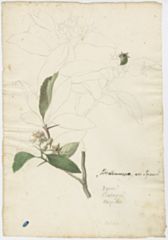Project 832: T. A. Dickinson, S. Han. 2023. What is Suksdorf’s hawthorn? revision of the western North American 20-stamen black-fruited hawthorns (Crataegus series Douglasianae, Rosaceae subtribe Malinae). Journal of the Botanical Research Institute of Texas. 17 (1):151-189.

Specimen: Crataegus ×suksdorfii (Sarg.) Kruschke (Hunt Institute for Botanical Documentation/Torner Collection: 6331.1959)
View: artwork
View: artwork
Abstract
An agamic complex of 20- and 10-stamen, black-fruited hawthorns (Crataegus subg. Sanguineae, sect. Douglasianae) occurs in western North America, with a 10-stamen taxon disjunct in the upper Great Lakes basin. Here, we recircumscribe the 20-stamen taxa at the core of this complex (C. ser. Douglasianae). This is needed in order to distinguish between a presumptively ancestral diploid and its allo- and autopolyploid derivatives, all differing in breeding system, distribution, morphology, and pattern of genetic variation. The earliest name for these 20-stamen taxa, Crataegus gaylussacia A. Heller, was given to distinctive plants of Marin and Sonoma counties in California that have recently been shown to be autotriploids. In Flora North America, however, this name was applied to all 20-stamen, black-fruited hawthorns. We recircumscribe C. gaylussacia, and also recircumscribe and typify a slightly younger name, C. suksdorfii (Sarg.) Kruschke, with a specimen from southern Washington with the diminished pollen fertility found in allopolyploid, apomictic black-fruited hawthorns occurring east of the Cascades, from northern California north to southernmost Alaska. Finally, we recognize the diploid, self-incompatible, sexual black-fruited hawthorns found west of the Cascades from northern California to southwestern Washington as Crataegus rhodamae-loveae sp. nov. Together with the 10-stamen, black-fruited hawthorns in predominantly tetraploid, apomictic, and self-fertile C. douglasii Lindl. and its segregates (discussed in detail in a companion paper), these species are linked by whole genome duplications associated in most cases with hybridization, with members of red-fruited C. subg. Americanae, and with each other. We suggest that this complex provides a model for understanding other such groups of Crataegus species that are related by whole genome duplications resulting from the fertilization of unreduced gametes (facilitated by but not necessarily dependent on occurrence of gametophytic apomixis), often together with hybridization. We note that an earlier effort at DNA barcoding these and other hawthorn species that provided limited support for our taxonomic decisions here also demonstrated some limited utility of the original plant DNA barcoding loci in groups like Crataegus. The taxonomic decisions we advocate will warrant consideration when other groups of hawthorns are revised in the light of data like those employed here.Read the article »
Article DOI: 10.17348/jbrit.v17.i1.1292
Project DOI: 10.7934/P832, http://dx.doi.org/10.7934/P832
| This project contains |
|---|
Download Project SDD File |
Currently Viewing:
MorphoBank Project 832
MorphoBank Project 832
- Creation Date:
06 December 2012 - Publication Date:
26 July 2023
Authors' Institutions ![]()
- University of Toronto
- Royal Ontario Museum
Members
| member name | taxa |
specimens |
media |
| Tim Dickinson Project Administrator | 14 | 1 | 1 |
| Shery Han Full membership | 0 | 0 | 0 |
| Jasmin Lantos Observer | 0 | 0 | 0 |
Project has no matrices defined.
Project downloads 
| type | number of downloads | Individual items downloaded (where applicable) |
| Total downloads from project | 7 | |
| Document downloads | 7 | Appendix 1. Vouchers for morphometric data for specimens of Crataegus ser. Douglasianae in Fig. 1 and 2. (2 downloads); Appendix 2. Voucher specimens for microsatellite data in Fig. 3 and 4. (2 downloads); Appendix 3. Vouchers for leaf margin data for specimens of Crataegus ser. Douglasianae in Fig. 5. (1 download); Appendix 4. Vouchers for pollen stainability data in Fig. 6, for individuals of Crataegus chrysocarpa Ashe and C. ser. Douglasianae. (2 downloads); |
